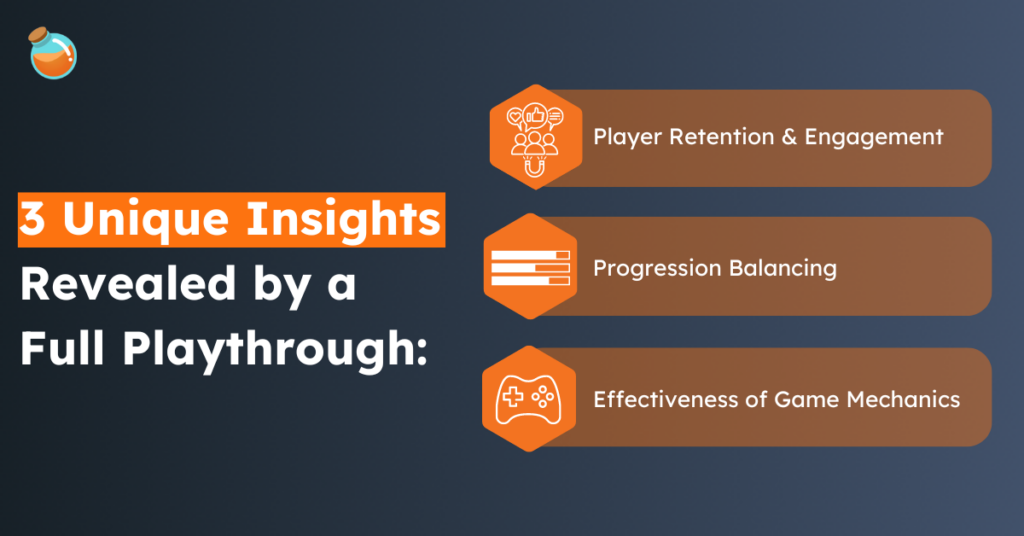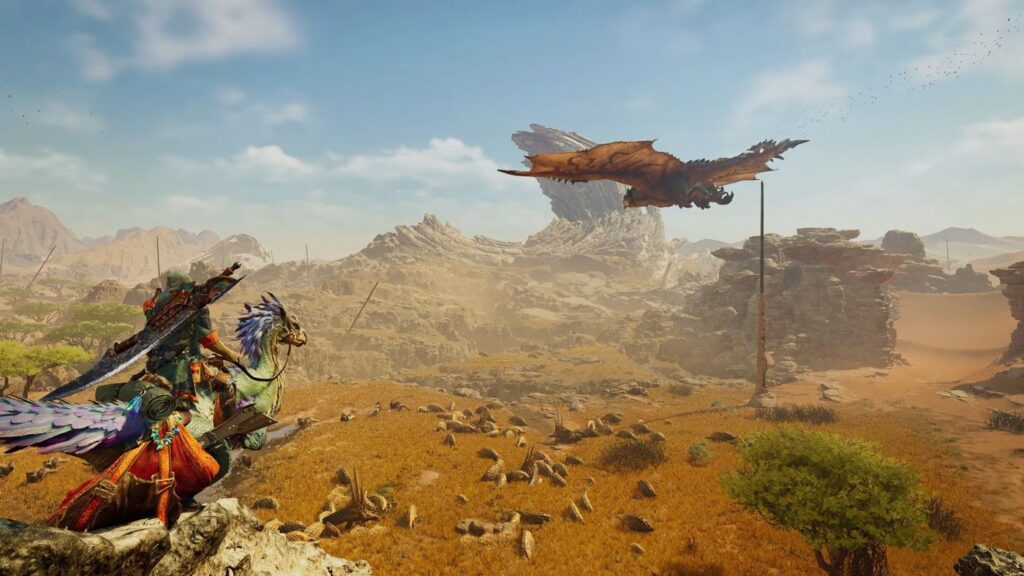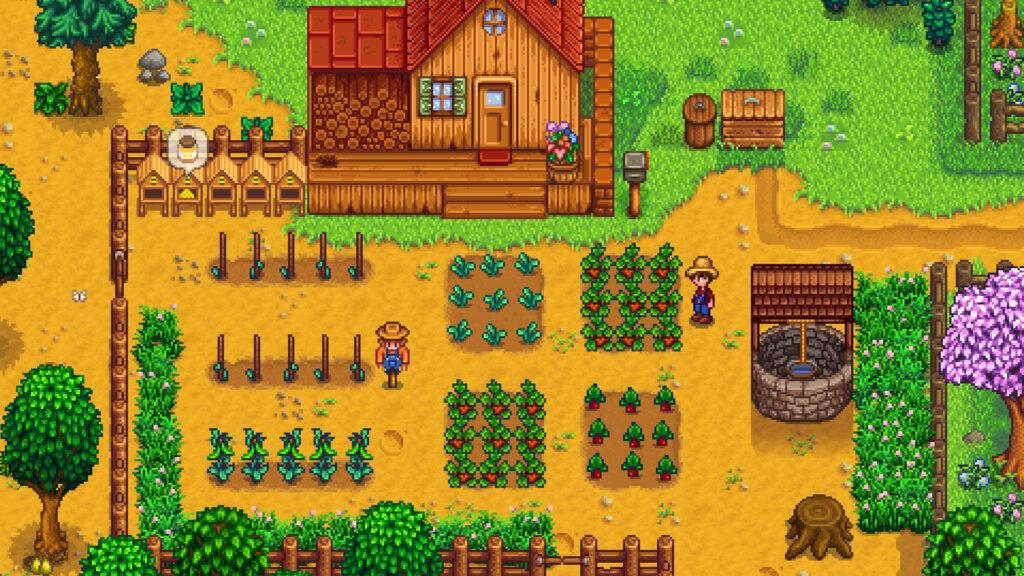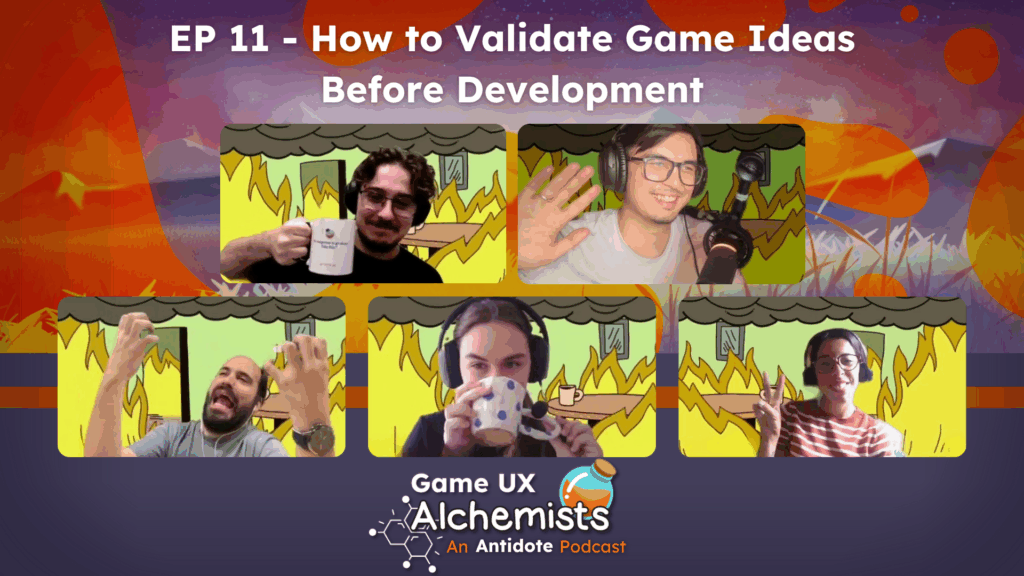Co-author: Theadora Vaxevanou, UX Researcher at Antidote
A full playthrough is a Game User Research (GUR) method that involves playtesting your game from start to finish. The aim is to closely observe how players interact with the game’s mechanics, engage with the narrative and perceive the overall gameplay experience.
But why should game studios consider conducting this research study?
To ensure that your game’s vision aligns with player expectations.
By having the participants complete the entire game, you can capture the entire player journey, catching details and insights that shorter sessions simply can’t.
This approach shows how all the aspects of your game work together and maintain the interest of your target audience over time.
In fact, a full playthrough reveals unique GUR insights that can assist with fine-tuning and improving your game for a more successful launch.
In this article, we’ll explore and discuss these insights, drawing from our extensive experience with conducting countless full playthrough studies.
A full playthrough aims to unveil the depth and dynamics of your game, ensuring that every element aligns with player expectations
Understanding the Full Playthrough
At its core, the full playthrough is all about immersion.
It lets the game’s narrative and mechanics unfold naturally, recording authentic reactions and opinions from the participants. This perspective is invaluable, offering developers a clear window into the game’s world from a player’s viewpoint.
Hence, it’s important to mention that the aim of the study is not to inform your team if the game is good or bad, but rather to offer insights into players’ experiences.
Unguided Playthroughs
For this research method, you can adopt either a moderated or unmoderated approach:
- Moderated: directly observing the players during the test, either in-person or remotely.
- Unmoderated: allowing players to complete the game on their own, without any intervention from the dev team.
Based on our experience, employing unmoderated (unguided) playthroughs are recommended for maximum-value extractions.
Why is that?
This approach seeks to gather real-life insights into how players interact with your game in their typical setting. Simulating a real-life environment encourages players to engage with your game as they would at home, on their own terms and time.
This strategy will help to reduce biased answers, prompt unfiltered opinions and encourage natural engagement with your game.
In contrast, moderated playthroughs, while offering a direct observation opportunity, risk influencing players’ natural responses and feedback. The awareness of being observed can deter players from acting spontaneously, potentially distorting the authenticity of their gameplay.
Instead, employing a moderated approach is effective for closely examining specific elements of interest. For instance, to evaluate the game’s iconography, pose targeted questions or seek in-depth feedback on particular segments of the gameplay.
However, it’s important to not leave players entirely without support, especially when encountering technical issues or significant gameplay challenges. Assisting with such hurdles ensures that you collect valuable feedback for future improvements and certify that all the players complete the full game.
From this, we can establish that it’s critical to strike a balance between study support and avoid influencing the authentic gameplay experience.
Now that we established the power of unguided playthroughs, we will explore what are the unique benefits of this GUR approach and how they can help with your game development process.
An unguided playthrough offers a lens into authentic gaming experience, capturing genuine opinions and interactions from your players
3 Unique Insights Revealed by a Full Playthrough
We recognize that creating a game demands substantial planning, work and investment from studios to transform initial concepts into reality.
Furthermore, the development process can span from one to several years, requiring a significant commitment from your team.
Given these efforts, it’s crucial to ensure that your final product aligns with what your target audience expects, boosting the prospects of a successful launch.
Below, we delve into three game-changing insights that only a full playthrough can uncover.

1. Player Retention & Engagement
Picture embarking on an exciting adventure without a map, only to discover uncharted territories that offer new perspectives on familiar landscapes.
Full playthroughs offer developers with such a map, charting the emotional peaks and valleys that your participants experience. Simply put, it offers a 360-degree view of how players connect with your game’s story, level of pacing and emotional engagement.
Why does this all matter?
In short, to test the retention rate of your game.
Playing from tutorial to final stages can unearth specific elements that might otherwise go unnoticed, from hidden glitches to levels that may confuse or disinterest players.
It’s during this exhaustive exploration that the nuances of the gaming experience come to light. For instance, moments where the storyline may drag or where the gameplay might falter in forming deep connections with the players.
Determining these moments can illuminate the stages that resonate with the players or cause churn due to boredom. This way, you can pinpoint exactly where most players quit or disengage with your game.
Moreover, it’s through these comprehensive insights that developers are equipped to make informed adjustments. Whether it’s tweaking the art design, refining levels or in some cases, even removing some elements entirely, these decisions are substantiated by a thorough understanding of the game as a whole.
Such changes are crucial not only for a smooth gaming experience, but also for ensuring that the final product resonates with its intended audience.
However, to maximize the effectiveness of the study, the game should be playtested in an environment that mirrors real-world conditions, played by individuals who are the game’s prospective buyers.
This real-life context is essential for capturing authentic reactions and feedback, providing developers with a clear and unfiltered perspective on how the game performs in the hands of its audience.
Success Examples

Alan Wake 2 is the sequel that builds on its predecessor’s legacy, enriching the dark, suspenseful story with deeper character development and a more immersive world.
The game’s remarkable storyline is elevated by the use of diverse creative mediums, an evocative soundtrack and chillingly themed artwork. These elements collectively played a pivotal role in securing the title of Best Narrative at The Game Awards 2023.
Remedy, a studio behind the game, also enlisted Antidote’s help with finding and recruiting the ideal players who assisted with playtesting the entire game before its official launch.
The team at Remedy meticulously refined every aspect of narrative delivery and gameplay mechanics. Their dedicated focus on the pacing of the story and on sustaining player engagement across the game’s entirety was instrumental in delivering an unparalleled gaming experience.

Final Fantasy VII Remake rejuvenates a beloved classic with a masterful blend of nostalgia and innovation. The game excels in captivating players through a reimagined narrative that respects its roots while introducing fresh and enchanting elements.
Key to its success is the dynamic integration of enhanced graphics, expanded storylines and a reworked combat system that breathes new life into the saga.
Characters receive deeper development and the world of Midgar is more detailed and vibrant, making every corner a discovery and every interaction meaningful.
This careful attention to narrative depth, character development and gameplay innovation has cemented its place as a revered title in the gaming industry.
By focusing on the outcomes of their storytelling and gameplay design, both Alan Wake 2 and Final Fantasy VII Remake demonstrate the profound impact that a well-crafted narrative and attentive game development can have on the success of a game.
2. Progression Balancing
A comprehensive playthrough of a whole game is invaluable for assessing the overall balance of gameplay.
It enables developers to identify inconsistencies in difficulty in certain stages and discrepancies in the in-game economy that might not be apparent during segmented testing or shorter play sessions.
Difficulty Balancing
A full playthrough allows developers to learn how players experience different levels or challenges during the gameplay. It ensures that the rising challenges complement the player’s growing skill set and the game’s overall narrative.
This detailed observation allows for discovering sections that are either too easy, failing to provide a challenge or too hard. As a result, it can frustrate players to the point of disengagement.
Adjusting these imbalances is crucial.
A well-balanced difficulty curve is essential for keeping players engaged and motivated throughout their journey. It ensures that the game presents a fair challenge that scales appropriately with player progression and skill development. It makes every victory feel earned and every setback a learning opportunity.
Optimal In-Game Economy
Reviewing the in-game economy via full playthroughs can unveil how your game offers a balanced and scalable gameplay environment.
This approach provides a clear view into how players earn, save and spend resources, revealing opportunities to refine the economic model for an optimal gaming experience.
A well-calibrated in-game economy underpins the game’s challenge while deepening player investment in the overall progression. By observing how real-life players utilize resources like currency and skill points, developers can adjust scarcity or abundance to motivate strategic play.
The fine-tuning is vital for inspiring continuous gameplay while averting player frustration from either resource shortages or an overly generous distribution that could dilute the game’s challenge.
It also introduces an additional layer of strategy, as players must make thoughtful decisions about resource allocation and how to spend the in-game currency, contributing to the game’s depth and replayability.
As a result, achieving the right equilibrium between economic progression and player effort can make or break your game’s appeal.
It will provide your players with a tangible sense of accomplishment when progressing through the story, encouraging ongoing participation and interaction with the game.
Success Examples

Capcom’s Monster Hunter series stands as a testament to the exceptional difficulty balancing.
In these games, players embark on epic quests to hunt down or trap large monsters in intricate ecosystems. Monster Hunter is renowned for its challenging gameplay that requires players to learn and master the behaviors of various monsters to succeed.
The difficulty curve is steep, yet it scales thoughtfully with player progression and skill development. Early quests introduce players to basic mechanics and monster patterns, while later hunts demand precise coordination, gear optimization and deep knowledge of each monster’s weaknesses.
This balance ensures that victories feel significant and well-earned, while defeats serve as learning experiences rather than discouragements.
The series demonstrates how managing difficulty levels can enhance player engagement, offering a fair but challenging experience that evolves with the player, making each hunt a thrilling and rewarding endeavor.

Stardew Valley exemplifies the successful use of in-game economy balancing. This farming simulation game, developed by ConcernedApe, immerses players in a charming pixelated world where they manage their farm, interact with townsfolk and explore cavernous mines.
What sets the game apart is its intricately designed economy system. Players must decide daily how to allocate their limited resources and time, whether to invest in crops, livestock, crafting or community relationships.
The game’s economy encourages strategic planning and rewards players for their investments and interactions within the game world.
The balance between effort, resource management and reward keeps players engaged for countless hours, proving that a well-balanced economy is essential for long-term player engagement and satisfaction.
3. Effectiveness of Game Mechanics
Understanding the impact of game mechanics over time is imperative for releasing a game that remains coherent and engaging from beginning to end.
A full playthrough allows developers to critically assess the whole gameplay experience from a bird’s-eye view, focusing on key developmental stages such as:
- Tutorial Stage: Introduction of the game’s rules and controls
- Mechanic Evolution: Scaling of mechanics from early to mid-game in parallel with player skill progression.
- Late-Game Stage: Depth of mechanics reflecting advanced player mastery.
- General Interaction: The mechanics’ influence on navigation and interaction within the game world.
Consistency and clarity in how the following stages are evolved is crucial for keeping players continuously engaged. Inconsistencies or abrupt alterations in mechanics can result in confusion, frustration and ultimately, player disengagement.
For example, introducing a control scheme for a specific action that later changes significantly without clear reasoning can disrupt the player’s learning curve and the flow of the game.
Similarly, feedback mechanisms such as visual or auditory cues indicating success, failure or environmental interactions, must remain consistent to avoid breaking the player’s sense of immersion and mastery over the game.
Moreover, the relevance of game mechanics over time is another critical aspect that full playthroughs can highlight. As players progress, their skills and understanding of the game evolve. Interactions that were initially challenging might become repetitive or less satisfying without a planned path.
Having the participants complete the game helps with identifying these shifts, which allows your dev team to adjust or introduce new mechanics that keep the gameplay fresh and players engaged.
This might involve scaling challenges, introducing new obstacles or providing alternative gameplay strategies that encourage players to explore the game.
Success Examples

‘Souls Games’, including renowned titles like Dark Souls and Elden Ring by FromSoftware, serve as prime examples of how effectively game mechanics can be utilized to maintain player engagement.
These games are well-known for their challenging combat systems that require players to learn enemy patterns, manage resources like stamina and time their attacks precisely, fostering a gameplay experience that rewards patience and strategy.

Some notable examples of engaging mechanics include the evolution of player abilities, introduction of new weapons and the consequence of losing currency upon death are ingenious feedback mechanisms that underscore the game’s unforgiving nature.
Another compelling mechanic found in Soul Games is the strategic use of environmental interactions that significantly impact gameplay. Players can use the terrain to their advantage during combat, such as luring enemies into traps or using narrow pathways to avoid being overwhelmed.
This emphasizes the importance of awareness while showcasing how the games encourage players to think creatively and interact with the world in meaningful ways
The following examples illustrate the depth and complexity that Souls Games offers, highlighting the crucial role of well-balanced game mechanics for success.
By enchanting players through challenging yet rewarding gameplay, studios can create gameplay experiences that retain players, setting the foundation for a victorious game.
Organizing a Full Playthrough
Now that you’re aware of the full playthrough study’s advantages, the question arises: what comes next?
Outlining your research study is the subsequent step, a task that can prove both challenging and time-intensive.
Drawing from our experience of conducting numerous playtests, we’ve pinpointed the following 3 key stages to consider when organizing your study:
- Player recruitment
- Coordinating the sessions
- Analyzing the results
To help you start, we will provide the necessary guidance for addressing each of these stages effectively.
Player Recruitment
The first step is to clearly define the desired demographic for your game.
Although full playthroughs usually only involve a small group of participants, it’s important for the playtesters to accurately represent your game’s intended audience, enabling you to capture authentic reactions and make necessary adjustments for improvement.
This requires a detailed understanding of potential players’ profiles, including their age, gender, location and gaming preferences.
Moreover, given the study’s demands, participants need the willingness and availability to complete the game across multiple sessions. With game lengths varying widely from 10 to over 40 hours, a clear communication of the playthrough duration is essential.
Participants must be informed about the time commitment required, ensuring they have the opportunity to engage with the game thoroughly over time. This transparency is key to securing the commitment needed for playthrough and avoiding mid-way drop-offs.
Such strategies ensure the recruitment process is tailored to attract participants who can offer feedback that’s both relevant and actionable, helping to refine your game effectively.
Coordinating the Sessions
A successful completion of the study hinges on keeping communication channels with participants active and responsive once the study commences.
This means conducting frequent check-ins to tackle any issues or concerns participants might raise, assisting with any technical difficulties they encounter and closely monitoring their gameplay progression.
To streamline this process, here are key measures to consider:
- Secure Game Distribution: Ensuring the game is distributed securely to prevent unauthorized access
- Establishing a Communication Channel: Setting up a dedicated channel for easy communication, such as Discord, enabling direct feedback and messages.
- Addressing Technical Issues: Being ready to quickly resolve any unexpected technical problems that arise to keep the playthrough on track.
- Ensuring Security: Implementing measures like an SDK to safeguard your game’s content
- Incorporating Live Moderation: Utilizing live moderation through video or audio recordings during critical gameplay stages
- Reward Distribution: Setting the value of your rewards and delivering them to your participants.
- Time Management: Providing enough time for the players to complete the full game
By planning the coordination and communication strategies for your study, you can significantly enhance the smoothness and effectiveness of your playtest.
Analyzing the Results
Reaching the analysis phase is where the real treasure lies, deciphering the insights unearthed from a full playthrough.
The goal of the study is to fully understand how your target audience engages with the complete version of your game, investigating every aspect of the user experience.
To achieve this, a qualitative research approach is essential. It allows you to delve into the depths of your participants’ opinions and feedback, typically through open-ended surveys, interviews and focus groups.
With surveys, consider segmenting them to target different stages of the game. You might have an initial survey focusing on first impressions of the tutorial, a midpoint survey evaluating the unfolding story and a final one gauging opinions on the overall pacing, as well as engagement.
Interviews and focus groups help to uncover the underlying motivations and perspectives of the players, providing invaluable insights into the “whys” behind their behavior and decision-making process. In these sessions, you can ask the participants to elaborate on challenges they encountered or aspects they particularly enjoyed.
Once all feedback is gathered, the critical step is transforming these insights into actionable feedback for your development team.
As you are dissecting qualitative data, you can conduct a thematic analysis to identify key themes and motifs that are common amongst the participants. For example, if multiple players express frustration at a particular level’s difficulty or highlight that a specific character has confusing mechanics.
These recurring points can guide targeted improvements in your game design.
To maximize the quality of your findings, integrating gameplay recordings, surveys and interviews allows for ‘data triangulation.’ This approach improves the reliability and precision of your recommendations by cross-referencing information from multiple sources.
Receiving Expert Help & Guidance
Navigating a full playthrough study can be an overwhelming task, especially for studios with tight schedules and looming deadlines.
Antidote offers support with the entire process, enabling you to receive player feedback effortlessly so you can focus on critical elements of your game development.
Our growing player community allows you to find the ideal participants who match your game’s target audience. This approach removes the need for launching recruitment campaigns, offering a straightforward solution to connect with your players and simplify the whole recruitment phase.
Furthermore, our in-house UX team is equipped to remotely manage the entirety of the study on your behalf using our Antidote platform, from designing the initial recruitment surveys to the final collection of user feedback.
This also includes coordinating time-consuming tasks such as:
- Sending reminders and managing player onboarding
- Setting up a dedicated Discord server for efficient communication
- Securing backups, if necessary
- Handling all ongoing communications, such as study inquiries
- Overseeing check-ins and monitoring gameplay progression
Alternatively, you can opt for our GUR-specialized UX Game Lab, based in the center of Barcelona. This allows you to playtest your game in a controlled environment under the supervision of our UX team, enhancing the security of your study.
Upon the study’s completion, we offer an optional UX report that distills the key points, themes and feedback uncovered by the full playthroughs. Within the report, our UX team will provide actionable recommendations that can be provided directly to your stakeholders.
Remember, game design is an iterative process that requires continuous feedback, testing, and refinement to get it right. Harnessing the insights from comprehensive playthroughs is crucial for fine-tuning your game to meet player expectation.
Our expert support aims to make the playtesting process more manageable and effective, directly addressing the challenges developers face in organizing comprehensive playthroughs.
Summary
In this article, we covered the three unique insights that a full playthrough playtest can reveal, which are:
- Player Retention and Engagement
- Progression Balancing
- Effectiveness of Game Mechanics
Each point is pivotal in understanding the interaction and perception players have with your game throughout its duration. The objective is to ensure that from the tutorial to the final boss fight, every segment of your game meets player expectations.
Identifying and addressing any elements that may diminish the gaming experience or cause confusion is key to fostering a deeper connection between your game and your players, which can lead to a more successful launch.
For studios seeking an experienced GUR partner to streamline the process of conducting a full playthrough study, Antidote is your go-to solution.
By working with us, your development team can focus on what truly matters, refining the game, rather than managing logistical tasks like reward distribution and player communication.
Contact us to discuss your project needs and let’s shape the future success of your game together!



